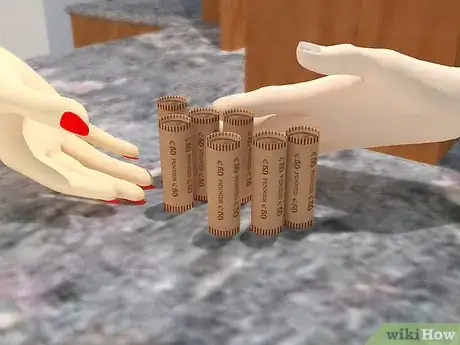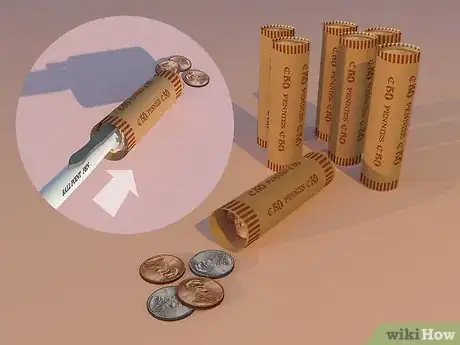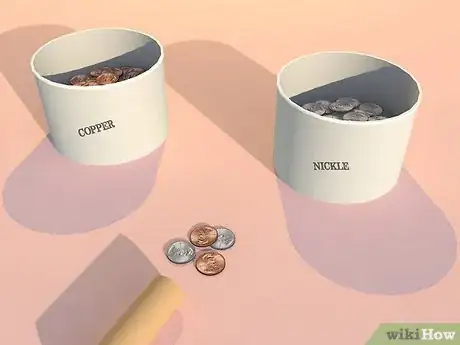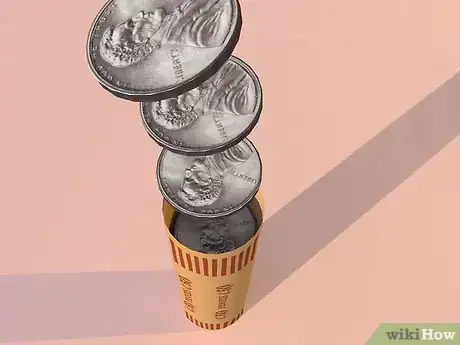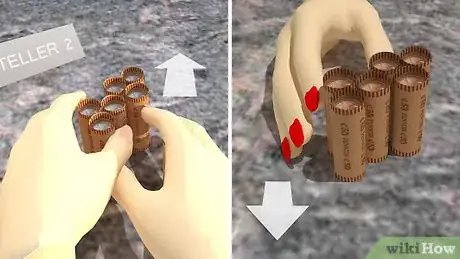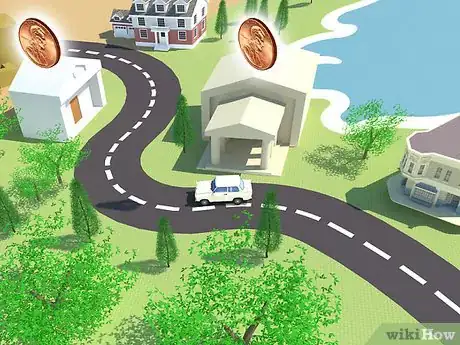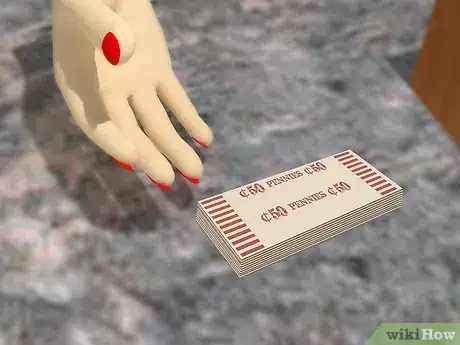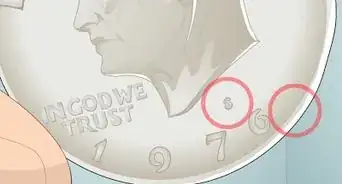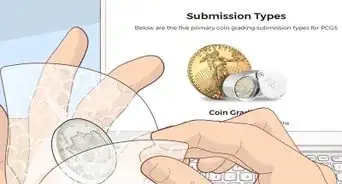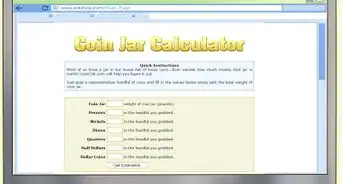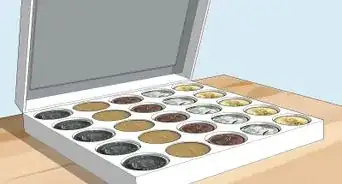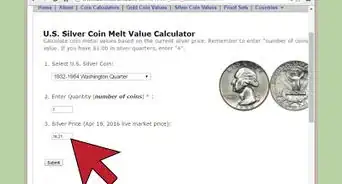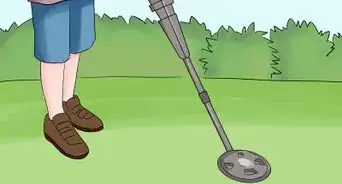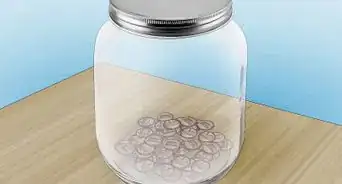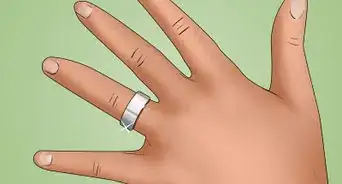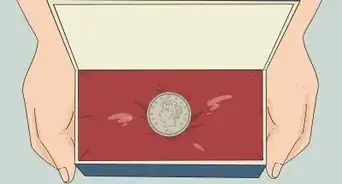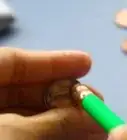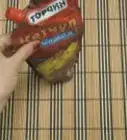wikiHow is a “wiki,” similar to Wikipedia, which means that many of our articles are co-written by multiple authors. To create this article, 26 people, some anonymous, worked to edit and improve it over time.
wikiHow marks an article as reader-approved once it receives enough positive feedback. In this case, 90% of readers who voted found the article helpful, earning it our reader-approved status.
This article has been viewed 286,612 times.
Learn more...
Copper prices have sharply risen in recent years, and many people are considering saving copper coinage to combat potential inflation. However, many zinc pennies have been produced since 1982 which are currently worth less than their face value in metal content. This article will describe how to efficiently collect pre-1982 copper pennies.
Steps
-
1Obtain rolls of pennies from your local bank. Pennies generally come in rolls of 50 cents, and boxes containing 50 rolls or $25. If possible, ask the bank for rolls that customers have brought in, as opposed to ones ordered from the Federal Reserve, as the coins tend to be older on average. However, even FR rolls can turn up substantial amounts of copper coins.
- Be aware that customer rolled coins may be short by 1 or 2 pennies occasionally, but this should be negligible considering you are going to obtain copper for well below its spot price.
- Go into large banks that service average small businesses, as these are usually better than going to a small "enterprise" bank, where they could pass the cost of the coin request on to you. (Yes, banks need to pay a small fee to order the coins.) If you're buying in bulk, it's best to open an account at the bank before you order the circulated rolls.
-
2Carefully unroll the coins without ripping the coin wrappers. You will need the wrappers later to re-roll your post-1982 zinc pennies.
- If the wrappers are folded, simply unfold the ends and dump the coins out. If the wrappers come from the federal reserve and are sealed, you will need to gently peel the end of the wrapper, and use a pencil/pen to push the coins out from the other end.
- It is important not to disturb the folding on the wrappers because they will indicate the size of the roll and allow you to avoid manually counting the coins later.
Advertisement -
3Obtain two containers to separate your copper and zinc pennies. Put the pennies that were minted 1981 and before in the copper container and any pennies minted in 1982 and after in the zinc container.
- Pay close attention to any valuable, rare pennies that you might find in the process. Consider reserving these pennies for another collection:
- 1943 steel pennies, issued during the war in order to save copper.
- "Wheat" pennies, made between 1909 and 1958, with two stalks of wheat instead of the Lincoln Memorial.
- Many others, including the famous double die obverse wheat penny, which bears a 1955 mint.
- Pay close attention to any valuable, rare pennies that you might find in the process. Consider reserving these pennies for another collection:
-
4Re-roll your zinc pennies. If you have handled the coin wrappers properly, it should not be too hard to tell how long the rolls should be by the fold on the wrappers. Alternatively, you can see if some banks will count your coins without a fee and sign up for an account there.
- It is generally not a good idea to use CoinStar unless you are planning to buy a gift card, so they waive the fee. Get to know what gift cards are offered so you can skip rolling the coins occasionally when you plan on shopping in these areas.
-
5Try to directly exchange the rolls of zinc pennies for new rolls of coins at the bank. Banks may be reluctant to exchange too many rolls for cash if they are running short, so exchanging them this way will offset the issue. Mark the wrappers of the rolls that you bring back, so you avoid getting the same rolls of coins back again.
-
6If you travel on the road a lot, try to get rolls of coins in various geographical areas. Circulated pennies don't necessarily travel long geographical distances.
-
7Stock up on wrappers. Many banks will give you free penny wrappers if you go in and ask for them. Stores try to sell them to you.
-
8Understand that it is currently illegal to melt the coins for their raw material. Even though the copper in these pennies is worth more than a their face value, the federal government has disallowed this practice for quite some time. Tampering, defacing, and otherwise destroying currency carries with it a sentence of up to six months in prison.[1]
Community Q&A
-
QuestionHow much are copper pennies worth?
 Jeff BelmontCommunity AnswerAs of 5/23/17, the copper value per penny is just above 1.5 cents. The zinc value also adds another .2 cents, so the metal value is 1.7 cents, almost 3/4 more than the face value.
Jeff BelmontCommunity AnswerAs of 5/23/17, the copper value per penny is just above 1.5 cents. The zinc value also adds another .2 cents, so the metal value is 1.7 cents, almost 3/4 more than the face value. -
QuestionWhere can I exchange my copper pennies for cash?
 Community AnswerYou can exchange them at pawn shops or other places that exchange money for pennies.
Community AnswerYou can exchange them at pawn shops or other places that exchange money for pennies. -
QuestionWho would purchase a 1937 penny?
 Community AnswerA local coin dealer may pay a low to high value for your penny depending on its condition, its mint mark (if any), and the country it originates from.
Community AnswerA local coin dealer may pay a low to high value for your penny depending on its condition, its mint mark (if any), and the country it originates from.
Warnings
- Avoid CoinStar unless you are buying a gift card.⧼thumbs_response⧽
- You won't get rich quick with hoarding pennies, and it can be rather time-consuming. However, hoarding pennies in lieu of other time-wasting activities (e.g. watching TV, surfing the net, etc) can be wise.⧼thumbs_response⧽
- Avoid driving to the bank for the sole purpose of collecting coins --- you will not recover your gasoline and depreciation costs. You can get coins when running errands or riding a bicycle.⧼thumbs_response⧽
- It is advisable to wear gloves when handling large quantities of coins.⧼thumbs_response⧽
- As of 2008 it is illegal to melt down or export pennies. However, it is likely that as copper prices rise the ban will be lifted due to increasing scarcity of copper.⧼thumbs_response⧽
- Keep your coins out of reach of babies, young children, and pets who may put them in their mouth.⧼thumbs_response⧽
